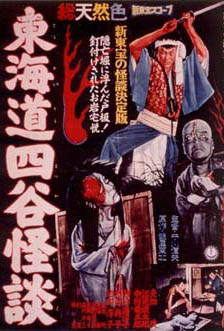 From 1959, a stunningly executed, no-nonsense exercise in old-fashioned ghost story chills. Superbly visualized and authentically scary, this Japanese near-masterpiece is one film that has definitely stood the test of time.
From 1959, a stunningly executed, no-nonsense exercise in old-fashioned ghost story chills. Superbly visualized and authentically scary, this Japanese near-masterpiece is one film that has definitely stood the test of time.
The “Ghost Story of Yotsuya” is an ancient Japanese folktale about a spiteful man who kills his wife, only to have her reappear as a ghost and hound him to his grave. Although this particular film is the one most people have seen, there have been at least ten others based on the tale and subsequent 19th Century theatrical adaptation by Nanboku Tsuruya.
The director was Nabuo Nakagawa, often referred to as the “Nippon Hitchcock” and probably best known for 1960’s JIGOKU (a.k.a. HELL), a visually opulent horror-fantasy with enough gore to fill a dozen H.G. Lewis flicks. It was, in other words, many years ahead of its time, not unlike GHOST STORY OF YOTSUYA (TOKAIDO YOTSUYA KAIDAN), which was also considered shocking and transgressive upon its original release (though it does seem rather tame by today’s standards).
A quick criticism: the first half is a bit too drawn-out and overcomplicated for its own good, but things pick up considerably once the horror kicks in during the story’s final third.
In feudal Japan, Lemon, a young samurai, stops an older samurai on a road to ask for his daughter Iwa’s hand in marriage. The old man rebuffs him, and an enraged Lemon retaliates by murdering the coot and his minions. He spares the life of one servant, Naosuke, after the latter agrees to help Lemon evade capture. They pin the murders on a local thief and subsequently kill another man, the companion of a woman Naosuke is interested in, by stabbing him in the back and pushing him over a waterfall.
Several months pass; Lemon and Iwa have a young child and find themselves living in poverty. Worse, Lemon has his eyes on Ume, the daughter of a wealthy man. He and Naosuke plot to kill Iwa by poisoning her and pinning the blame on a local masseur.
Iwa swallows the poison, which horribly disfigures her face. As she dies, she realizes her husband’s treachery and kills their infant son before breathing her last. Lemon returns, finds the bodies and the still-living masseur, and brutally murders him. He and Naosuke nail the carcasses of Iwa and the masseur to either side of a board and sink the whole thing in a lake. But later that night Lemon hears his wife’s ghostly voice talking to him, and sees her deformed visage on ceilings, emerging from the lake, etc. Lemon is eventually driven mad by the ghostly visitations, killing everyone around him and, inevitably, ending up dead himself.
Nobuo Nakasawa’s widescreen compositions are stunning, as are the eye-popping colors. Visually, GHOST STORY OF YOTSUYA ranks alongside the films of Japanese masters like Teinosuke Kinugasa (GATE OF HELL), Kon Ichikawa (FIRES ON THE PLAIN) and Akira Kurosawa. The film is unapologetically stagy, which gives Nakasawa great control over color and mood (a storm is announced by simply dimming the stage lights) and imparts an unreal, dreamlike ambiance.
Nakasawa’s flair for pure horror is as proficient as that of anyone. A shot of the just-poisoned wife catching a glimpse of her hideously disfigured face in a mirror ranks with the greatest horror movie images of all time. Her subsequent ghostly appearances, accompanied by discordant musical cues, were an evident influence on THE SHINING. The bright, gorgeous color scheme, for its part, foreshadows the films of Mario Bava (BLACK SUNDAY, THE WHIP AND THE BODY, etc.) and Masaki Kobayashi, whose 1964 horror epic KWAIDAN owes much to this film. As in Bava and Kobayashi’s works, the supernatural is announced by otherworldly shades of red and green, erupting into otherwise unremarkable landscapes.
Vital Statistics
GHOST STORY OF YOTSUYA (TOKAIDO YOTSUYA KAIDAN)
Shintoho Company Ltd.
Director: Nobuo Nakagawa
Producer: Mitsugu Okura
Screenplay: Yoshihiro Ishikawa, Masayoshi Onuki
(Based on the play by Nanboku Tsuruya)
Cinematography: Tadashi Nishimoto
Cast: Shigeru Amachi, Noriko Kitazawa, Shuntaro Emi, Junko Ikeuchi, Ryozaburo Nakamura, Jun Otomo, Kazuko Wakasugi
